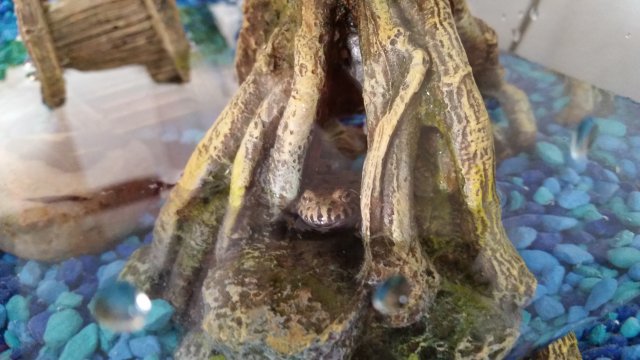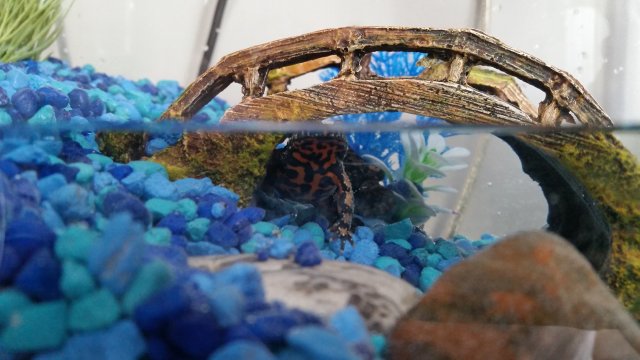Fire belly toads
- Thread starter jaws7777
- Start date
You are using an out of date browser. It may not display this or other websites correctly.
You should upgrade or use an alternative browser.
You should upgrade or use an alternative browser.
Nice decor thoughMy sons been having some medical issues so besides spoiling him with toys we picked up 3 little fire belly toads...not my thing but hes wanted them for a while. Any tips on care ?
P.s i had nothing to do with decorating the tank
View attachment 1167922 View attachment 1167921 View attachment 1167920 View attachment 1167919
Affriad not much knowledge about fire belly toads.
Hope your son feels better real soon....
edit-my first post was supposed to be "know whats up" not "that's up"
edit-my first post was supposed to be "know whats up" not "that's up"
Thx man. Kids taken 10 urs off my life already
Hope your son feels better real soon....
edit-my first post was supposed to be "know whats up" not "that's up"
I hear that, keep your head up. Some things are in our control, some aren't. God bless
they're very easy to keep
J
jaws7777
......only thing I'd really add is some Zoo meds Sphagnum Moss....great stuff, soaks up the water and keeps humidity better, plus they will use it for cover and shelter, especially if they decide to mate. You should have no problem getting them to eat pellet food, shrimp, Krill, etc and for live food go with crickets, waxworms or butterworms....mealworms are pretty useless, and Dubia roaches are ridiculously healthy. Give everything a light dusting in Herptivite Calcium/Vitamin powder - you should buy 2 different kinds - 1 WITH Vitamin D3 which is used only once a week (you can overdose on D3), and one withOUT D3 which should be used every other day.
Temps should be tropical 80-85F is fine, they are not picky and they will also benefit from a Zoo Med 5.0 UVB light. This will aid in the nutrition process - the UVB allows them to process D3 which in turn allows their bodies to absorb Calcium. Test water as you would for fish, amphibians absorb toxins through their skin, so chlorine is a no-no, ammonia bad, etc etc.
Honestly, not really any pro-tips for them, they are pretty basic , good for kids to learn too. You could probably find anything you want to know about them on Wikipedia since they are so popular. Anything in particular you wanted to know?
Temps should be tropical 80-85F is fine, they are not picky and they will also benefit from a Zoo Med 5.0 UVB light. This will aid in the nutrition process - the UVB allows them to process D3 which in turn allows their bodies to absorb Calcium. Test water as you would for fish, amphibians absorb toxins through their skin, so chlorine is a no-no, ammonia bad, etc etc.
Honestly, not really any pro-tips for them, they are pretty basic , good for kids to learn too. You could probably find anything you want to know about them on Wikipedia since they are so popular. Anything in particular you wanted to know?
At the risk of being blunt, you haven't gotten any good advice thus far. You really don't want any loose substrate with these guys whatsoever... anything that small and not tied down in their enclosure is liable to get swallowed, and swallowing a big piece of moss or gravel could lead to their death.
They also create a massive amount of waste, which can become very difficult to clean up as it soaks into the substrate... especially because they need a very wet environment. The smell of dirty, wet toad substrate is something to behold. So first things first... ditch the gravel, and definitely don't put any moss in there.
I set up my firebelly toads with a water substrate, and then built them an island to haul out and bask on. This enclosure has worked well for several years now. Being semi-aquatic, but also semi-terrestrial, it is imperative that they are able to swim and move around on dry land.
Like all amphibians, they require a varied diet to thrive. These guys are big eaters and will pretty much eat anything that moves. I feed mine crickets, mealworms, waxworms, chopped nightcrawlers, butterworms, and frozen bloodworms from tongs. As they get more used to you bringing them food, they will come to the front of the cage when they see you, which makes tong feeding easy. Incidentally, this same behavior is what makes not having loose substrate imperative... when they become frenzied, they attack everything in sight, including cage decor, fingers, and each other. They don't have teeth, so they cant hurt us and the usually don't injure each other, but they can and will end up eating the substrate that way.
Their food should occasionally be dusted with a calcium/vitamin D3 supplement. They are not choosy about water temperature, and will thrive if temperatures are anywhere between the upper fifties and the high seventies.
Hope your son enjoys his toads, and feels better soon.
For reference, here's my enclosure, and my toads. I've found this type of enclosure to be by far the easiest to clean, safest, and most dynamic way to keep semi-aquatic amphibians.
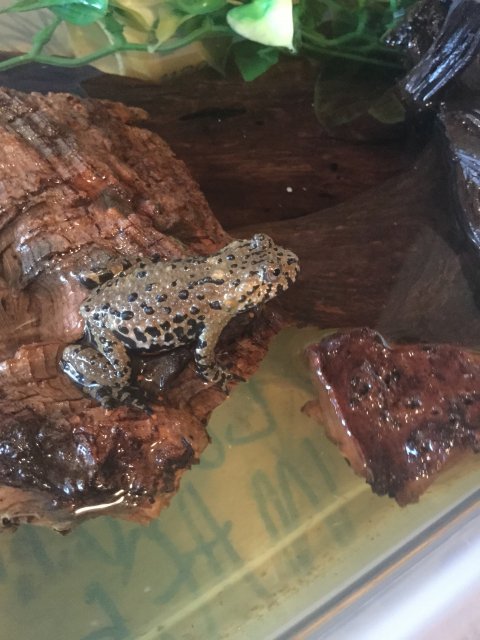
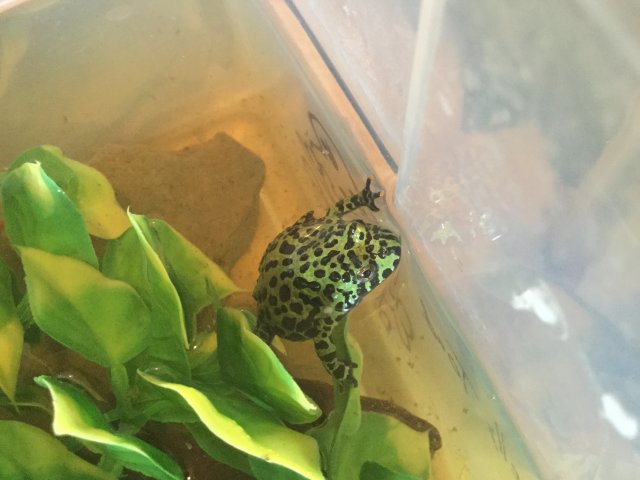

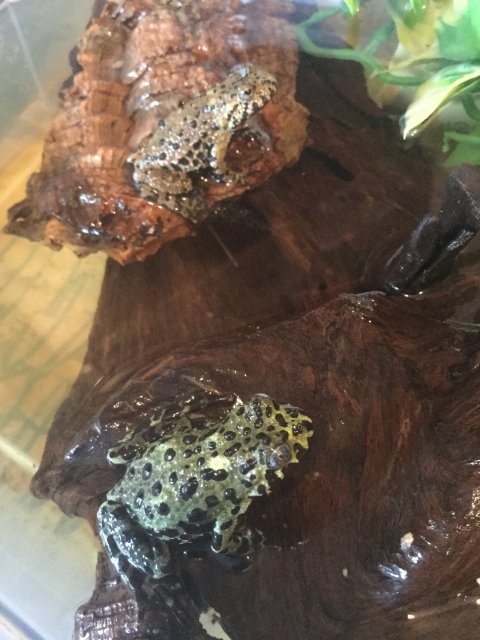
They also create a massive amount of waste, which can become very difficult to clean up as it soaks into the substrate... especially because they need a very wet environment. The smell of dirty, wet toad substrate is something to behold. So first things first... ditch the gravel, and definitely don't put any moss in there.
I set up my firebelly toads with a water substrate, and then built them an island to haul out and bask on. This enclosure has worked well for several years now. Being semi-aquatic, but also semi-terrestrial, it is imperative that they are able to swim and move around on dry land.
Like all amphibians, they require a varied diet to thrive. These guys are big eaters and will pretty much eat anything that moves. I feed mine crickets, mealworms, waxworms, chopped nightcrawlers, butterworms, and frozen bloodworms from tongs. As they get more used to you bringing them food, they will come to the front of the cage when they see you, which makes tong feeding easy. Incidentally, this same behavior is what makes not having loose substrate imperative... when they become frenzied, they attack everything in sight, including cage decor, fingers, and each other. They don't have teeth, so they cant hurt us and the usually don't injure each other, but they can and will end up eating the substrate that way.
Their food should occasionally be dusted with a calcium/vitamin D3 supplement. They are not choosy about water temperature, and will thrive if temperatures are anywhere between the upper fifties and the high seventies.
Hope your son enjoys his toads, and feels better soon.
For reference, here's my enclosure, and my toads. I've found this type of enclosure to be by far the easiest to clean, safest, and most dynamic way to keep semi-aquatic amphibians.







